CHEVROLET MONTE CARLO 1973 2.G Workshop Manual
Manufacturer: CHEVROLET, Model Year: 1973, Model line: MONTE CARLO, Model: CHEVROLET MONTE CARLO 1973 2.GPages: 86, PDF Size: 33.46 MB
Page 51 of 86
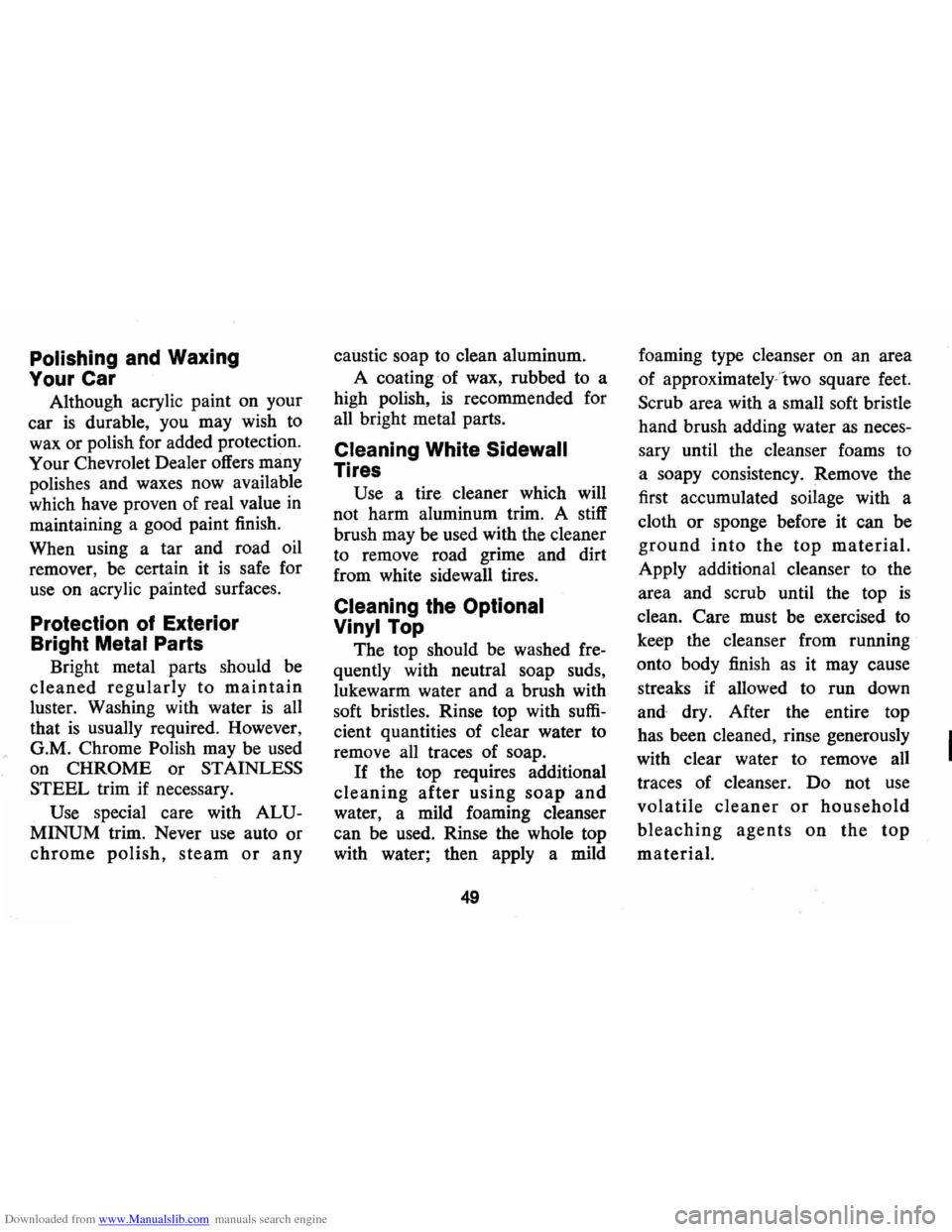
Downloaded from www.Manualslib.com manuals search engine Polishing and Waxing
Your Car
Although acrylic paint on your
car
is durable, you may wish to
wax or polish for added protection.
Your Chevrolet Dealer offers many
polishes and waxes now available
which have proven of real value
in
maintaining a good paint finish.
When using a tar and road oil
remover, be certain it
is safe for
use on acrylic painted surfaces.
Protection of Exterior
Bright
Metal Parts
Bright metal parts should be
cleaned regularly to maintain
luster. Washing with water is all
that
is usually required. However,
G.M. Chrome
Polish may be used
on CHROME or STAINLESS
STEEL
trim if necessary.
Use special care with ALU
MINUM trim. Never use auto or
chrome polish, steam or any caustic
soap to clean aluminum.
A coating of wax, rubbed to a
high polish,
is recommended for
all bright metal parts.
Cleaning White Sidewall
Tires
Use a tire cleaner which will
not harm aluminum trim. A stiff
brush may be used with the cleaner
to remove road grime and dirt
from white sidewall tires.
Cleaning the Optional
Vinyl
Top
The top should be washed fre
quently with neutral soap suds,
lukewarm water and a brush with
soft bristles. Rinse top with
suffi
cient quantities of clear water to
remove all traces of soap.
If the top requires additional
cleaning after using soap and
water, a mild foaming cleanser
can be used. Rinse the whole top
with water; then apply a mild
49
foaming type cleanser on an area
of approximately
--two square feet.
Scrub area with a small soft bristle
hand brush adding water
as neces
sary until the cleanser foams to
a soapy consistency. Remove the
first accumulated soilage with a
cloth or sponge before it can be
ground into the top material.
Apply additional cleanser to the
area and scrub until the top
is
clean. Care must be exercised to
keep the cleanser from running
onto body finish
as it may cause
streaks
if allowed to run down
and dry. After the entire top
has been cleaned, rinse generously
with clear water to remove all
traces of cleanser.
Do not use
volatile cleaner or household
bleaching agents on the top
material.
I
Page 52 of 86
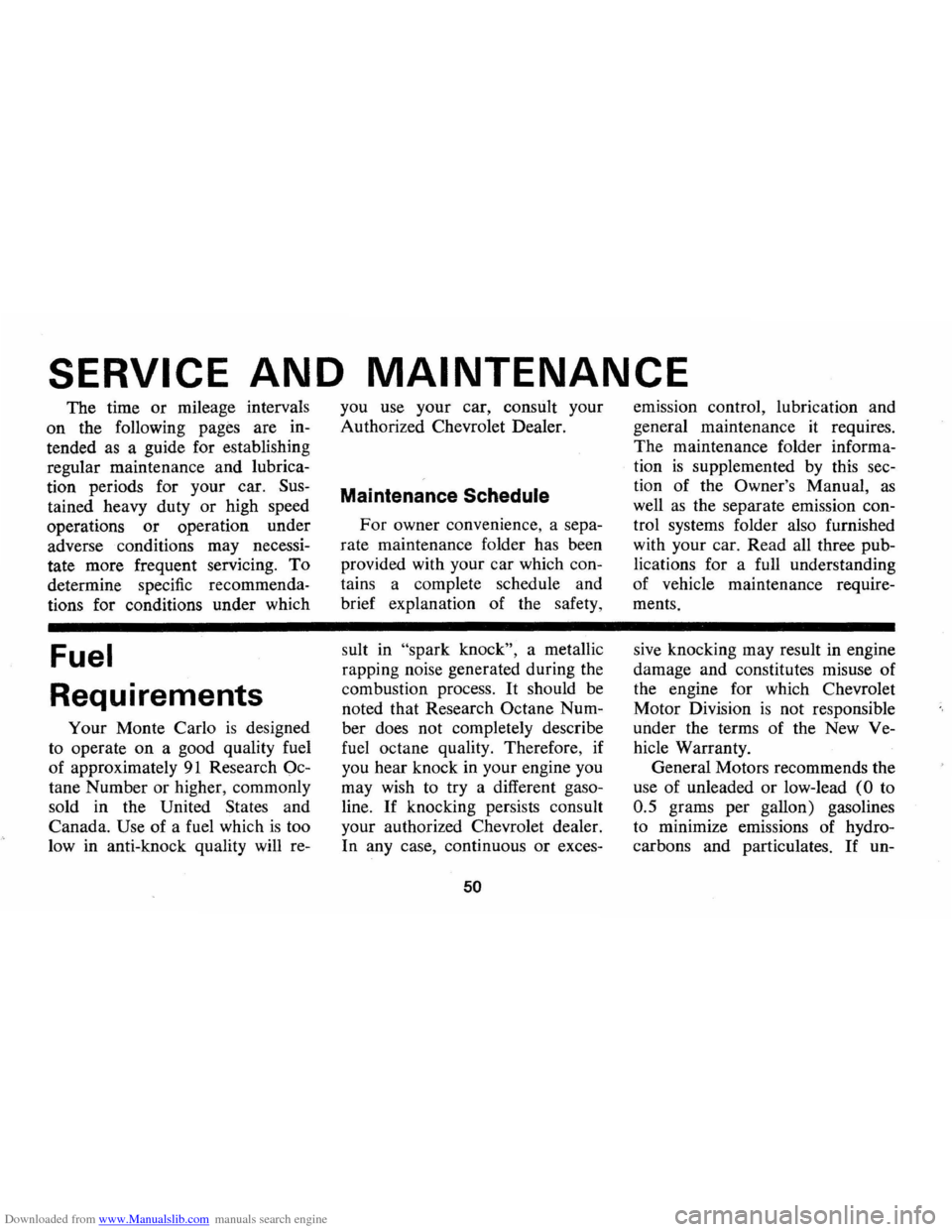
Downloaded from www.Manualslib.com manuals search engine SERVICE AND MAINTENANCE
The time or mileage intervals
on the following
pages are in
tended as a guide for establishing
regular maintenance and lubrica
tion periods for your car. Sus
tained heavy duty or high speed
operations
or operation under
adverse conditions may necessi
tate more frequent servicing.
To
determine specific recommenda
tions for conditions under which
Fuel
Requirements
Your Monte Carlo is designed
to operate
on a good quality fuel
of approximately
91 Research Oc
tane Number or higher , commonly
sold in the United States and
Canada.
Use of a fuel which is too
low in anti-knock quality will re- you
use your car, consult your
Authorized Chevrolet Dealer.
Maintenance Schedule
For owner convenience, a sepa
rate maintenance folder has been
provided with your car which con
tains a complete schedule and
brief explanation of the safety,
suIt in
"spark knock", a metallic
rapping noise generated during the
combustion process. It should be
noted that Research Octane Num
ber does not completely describe
fuel octane quality. Therefore , if
you hear knock in your engine you
may wish to try a different gaso
line.
If knocking persists consult
your authorized Chevrolet dealer.
In any case, continuous
or exces-
50
emission control, lubrication and
general maintenance it requires.
The maintenance folder informa
tion
is supplemented by this sec
tion of the Owner 's Manual,
as
well as the separate emission con
trol systems folder also furnished
with your car. Read all three pub
lications for a full understanding
of vehicle maintenance require
ments.
sive knocking may result in engine
damage and constitutes misuse of
the engine for which Chevrolet
Motor Division
is not responsible
under the terms of the New Ve
hicle Warranty.
General Motors recommends the
use of unleaded or low-lead
(0 to
0.5 grams per gallon) gasolines
to minimize emissions of hydro
carbons and particulates.
If un-
Page 53 of 86
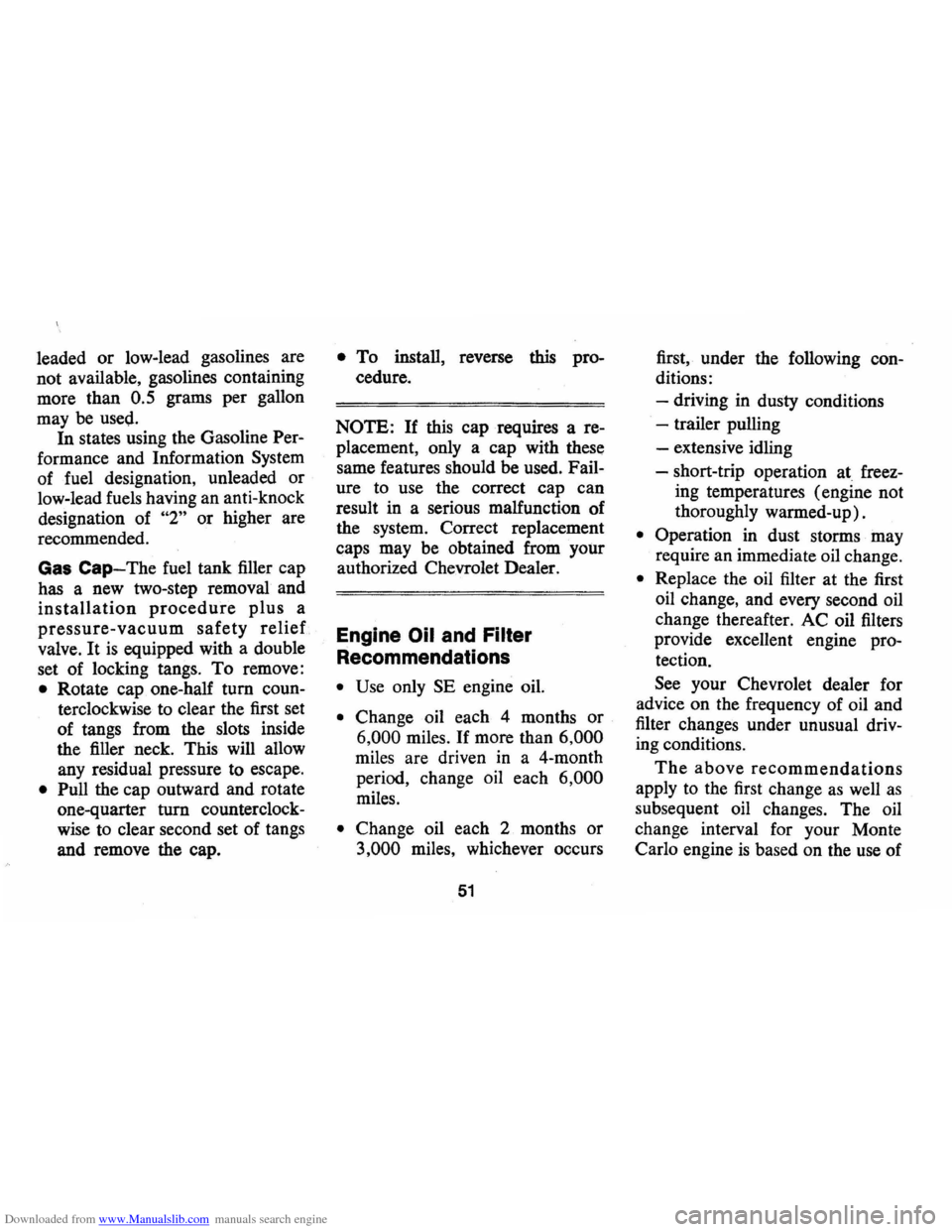
Downloaded from www.Manualslib.com manuals search engine leaded or low-lead gasolines are
not available, gasolines containing
more than 0.5 grams per gallon
may be used.
In states using the Gasoline Per
formance and Information
System
of fuel designation, unleaded or
low-lead fuels having an anti-knock
designation of
"2" or higher are
recommended.
Gas Cap-The fuel tank filler cap
has a new two-step removal and
installation procedure plus a
pressure-vacuum safety relief.
valve. It is equipped with a double
set of locking tangs.
To remove:
• Rotate cap one-half tum coun
terclockwise to clear the first set
of tangs from the slots inside
the filler neck.
This, will allow
any residual pressure to escape.
• Pull the cap outward and rotate
one-quarter
tum counterclock
wise to clear second set of tangs
and remove the cap.
• To install, reverse this pro
cedure.
NOTE: If this cap requires a re
placement, only a cap with these
same features should be used. Fail
ure to use the correct cap can
result in a serious malfunction of
the system. Correct replacement
caps may be obtained from
your
authorized Chevrolet Dealer.
Engine Oil and Filter
Recommendations
• Use only SE engine oil.
• Change oil each 4 months or
6,000 miles. If more than 6,000
miles are driven in a 4-month
period, change oil each
6,000
miles.
• Change oil each 2 months or
3,000 miles, whichever occurs
51
first, under the following con
ditions:
- driving in dusty conditions
- trailer pulling
- extensive idling
- short-trip operation
at freez-
ing temperatures (engine not
thoroughly warmed-up).
• Operation in dust storms may
require an immediate oil change.
• Replace the oil filter at the first
oil change, and every second oil
change thereafter.
AC oil filters
provide excellent engine pro
tection.
See your Chevrolet dealer for
advice
on the frequency of oil and
filter changes under unusual driv
ing conditions.
The above recommendations
apply to the first change as well as
subsequent oil changes. The oil
change interval for your Monte
Carlo engine
is based on the use of
Page 54 of 86
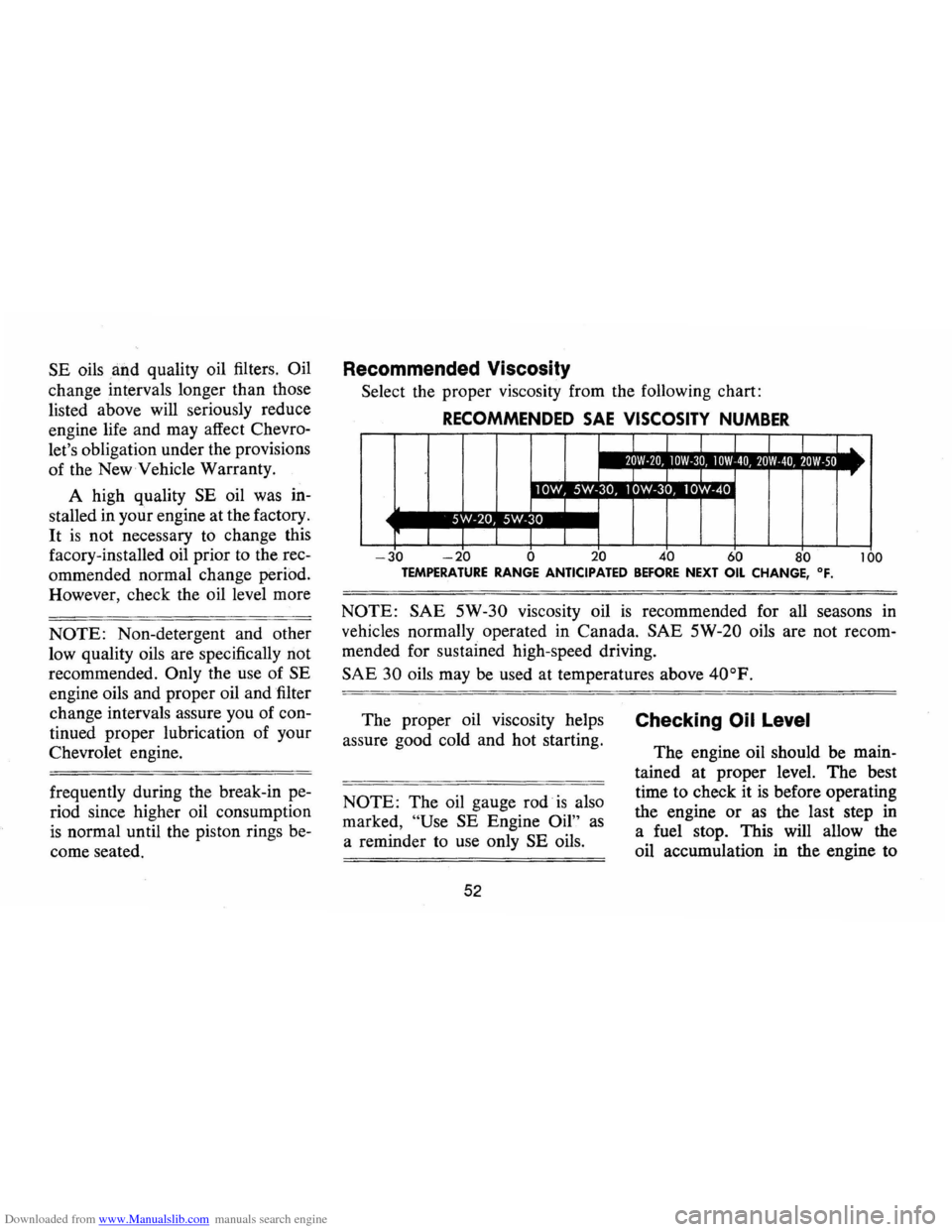
Downloaded from www.Manualslib.com manuals search engine SE oils and quality oil filters. Oil
change intervals longer than those
listed above will seriously reduce
engine life and may affect Chevro
let's obligation under the provisions
of the New Vehicle Warranty.
A high quality
SE oil was in
stalled in your engine at the factory.
It is not necessary to change this
facory-installed oil prior
to the rec
ommended normal change period.
However, check the oil level more
NOTE: Non-detergent and other
low quality oils are specifically not
recommended.
Only the use of SE
engine oils and proper oil and filter
change intervals assure you of con
tinued proper lubrication of your
Chevrolet engine.
frequently during the break-in pe
riod since higher oil consumption
is normal until the piston rings be
come seated.
Recommended Viscosity
Select the proper viscosity from the following chart:
RECOMMENDED SAE VISCOSITY NUMBER
I ,.
.... ~.-."'). ... .II ••• :.; I
-30 -20 0 20 40 60 80 100 TEMPERATURE RANGE ANTICIPATED BEFORE NEXT OIL CHANGE, OF.
NOTE: SAE 5W-30 viscosity oil is recommended for all seasons in
vehicles normally operated in Canada.
SAE 5W-20 oils are not recom
mended for sustained high-speed driving.
SAE 30 oils may be used at temperatures above 40oP.
The proper oil viscosity helps
assure good cold and hot starting.
NOTE: The oil gauge rod is also
marked,
"Use SE Engine Oil" as
a reminder to use only SE oils.
52
Checking Oil Level
The engine oil should be main
tained at proper level. The best
time to check it
is before operating
the engine or
as the last step in
a fuel stop. This will allow the
oil accumulation in the engine to
Page 55 of 86
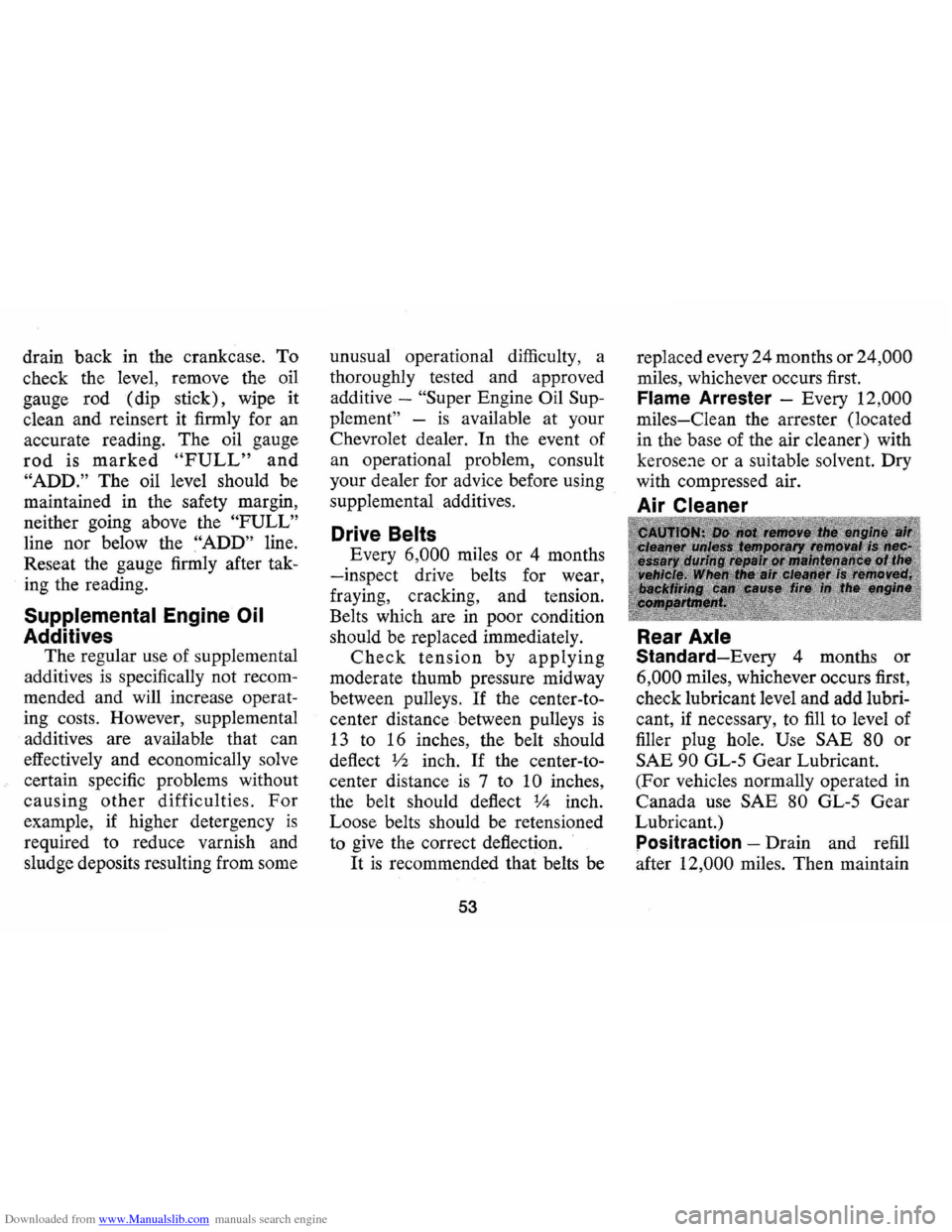
Downloaded from www.Manualslib.com manuals search engine drain back in the crankcase. To
check the level, remove the oil
gauge rod (dip stick), wipe
it
clean and reinsert it firmly for an
accurate reading. The oil gauge
rod is marked "FULL" and
"ADD." The oil level should be
maintained in the safety margin,
neither going above the
"FULL"
line nor below the "ADD" line.
Reseat the gauge firmly after tak
ing the reading.
Supplemental Engine Oil
Additives
The regular use of supplemental
additives
is specifically not recom
mended and will increase operat
ing costs. However, supplemental
additives are available that can
effectively and economically solve
certain specific problems without
causing other difficulties. For
example, if higher detergency is
required to reduce varnish and
sludge deposits resulting from some unusual
operational difficulty, a
thoroughly tested and approved
additive
- "Super Engine Oil Sup
plement " -
is available at your
Chevrolet dealer.
In the event of
an operational problem, consult
your dealer for advice before using
supplemental additives.
Drive Belts
Every 6,000 miles or 4 months
-inspect drive belts for wear,
fraying, cracking, and tension.
Belts which are in poor condition
should be replaced immediately.
Check tension by applying
moderate thumb pressure midway
between pulleys.
If the center-to
center distance · between pulleys
is
13 to 16 inches, the belt should
deflect
1/2 inch. If the center-to
center distance
is 7 to 10 inches ,
the belt should deflect
~ inch.
Loose belts should be retensioned
to give the correct deflection.
It
is recommended that belts be
53
replaced every 24 months or 24,000
miles, whichever occurs first.
Flame Arrester -Every 12,000
miles-Clean the arrester (located
in the base of the air cleaner) with
kerose:le or a suitable solvent. Dry
with compressed air.
Air Cleaner
Rear
Axle
Standard-Every 4 months or
6,000 miles, whichever occurs first,
check lubricant level and add lubri
cant, if necessary, to
fill to level of
filler plug hole.
Use SAE 80 or
SAE 90 GL-5 Gear Lubricant.
(For vehicles normally operated in
Canada use
SAE 80 GL-5 Gear
Lubricant.)
Positraction -Drain and refill
after
12,000 miles. Then maintain
Page 56 of 86
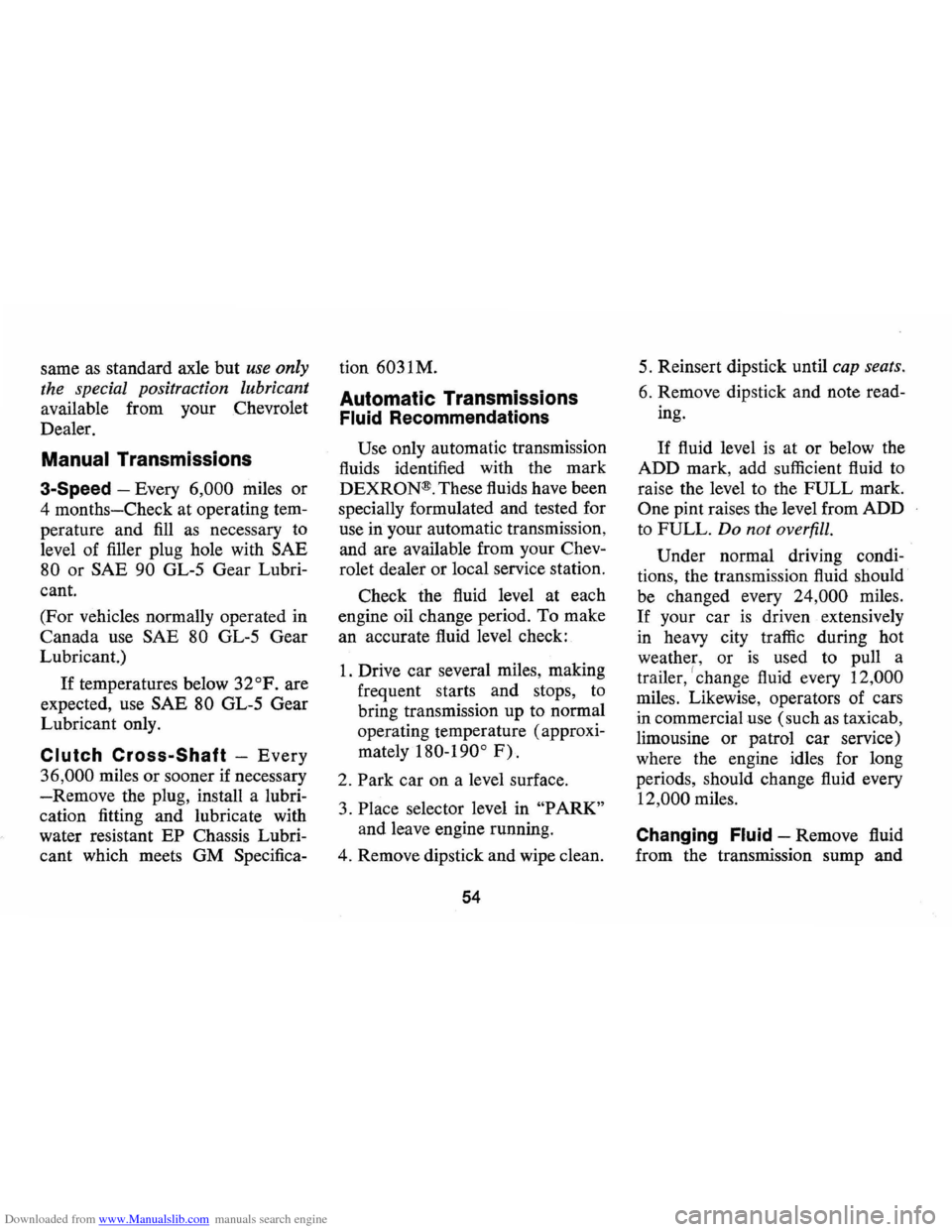
Downloaded from www.Manualslib.com manuals search engine same as standard axle but use only
the special positraction lubricant
available from your Chevrolet
Dealer.
Manual Transmissions
3-Speed -Every 6,000 miles or
4 months-Check at operating tem
perature and
fill as necessary to
level of filler plug hole with SAE
80
or SAE 90 GL-5 Gear Lubri
cant.
(For vehicles normally operated in
Canada use
SAE 80 GL-5 Gear
Lubricant.)
If temperatures below 32°F. are
expected, use
SAE 80 GL-5 Gear
Lubricant only.
Clutch Cross-Shaft -Every
36,000 miles or sooner if necessary
-Remove the plug, install a lubri
cation fitting and lubricate with
water resistant
EP Chassis Lubri
cant which meets GM Specific
a-
tion 6031M.
Automatic Transmissions
Fluid Recommendations
Use only automatic transmission
fluids identified with the mark
DEXRON ®. These fluids have been
specially formulated and tested for
use in your automatic transmission,
and are available from your Chev
rolet dealer or local service station.
Check the fluid level at each
engine oil change period. To make
an accurate fluid level check:
1. Drive car several miles, making
frequent starts and stops,
to
bring transmission up to normal
operating temperature (approxi
mately
180-190° F).
2. Park car on a level surface.
3. Place selector level in "PARK"
and leave engine running.
4. Remove dipstick and wipe clean.
54
5. Reinsert dipstick until cap seats.
6. Remove dipstick and note read
ing.
If fluid level is at or below the
ADD mark, add sufficient fluid
to
raise the level to the FULL mark.
One pint raises the level from ADD
to FULL.
Do not overfill.
Under normal driving condi
tions, the transmission fluid should
be changed every
24,000 miles.
If your car is driven extensively
in heavy city traffic during hot
weather, or
is used to pull a
trailer, {change fluid every
12,000
miles. Likewise, operators of cars
in commercial use (such
as taxicab,
limousine or patrol car service)
where the engine idles for long
periods, should change fluid every
12,000 miles.
Changing Fluid -Remove fluid
from the transmission sump and
Page 57 of 86
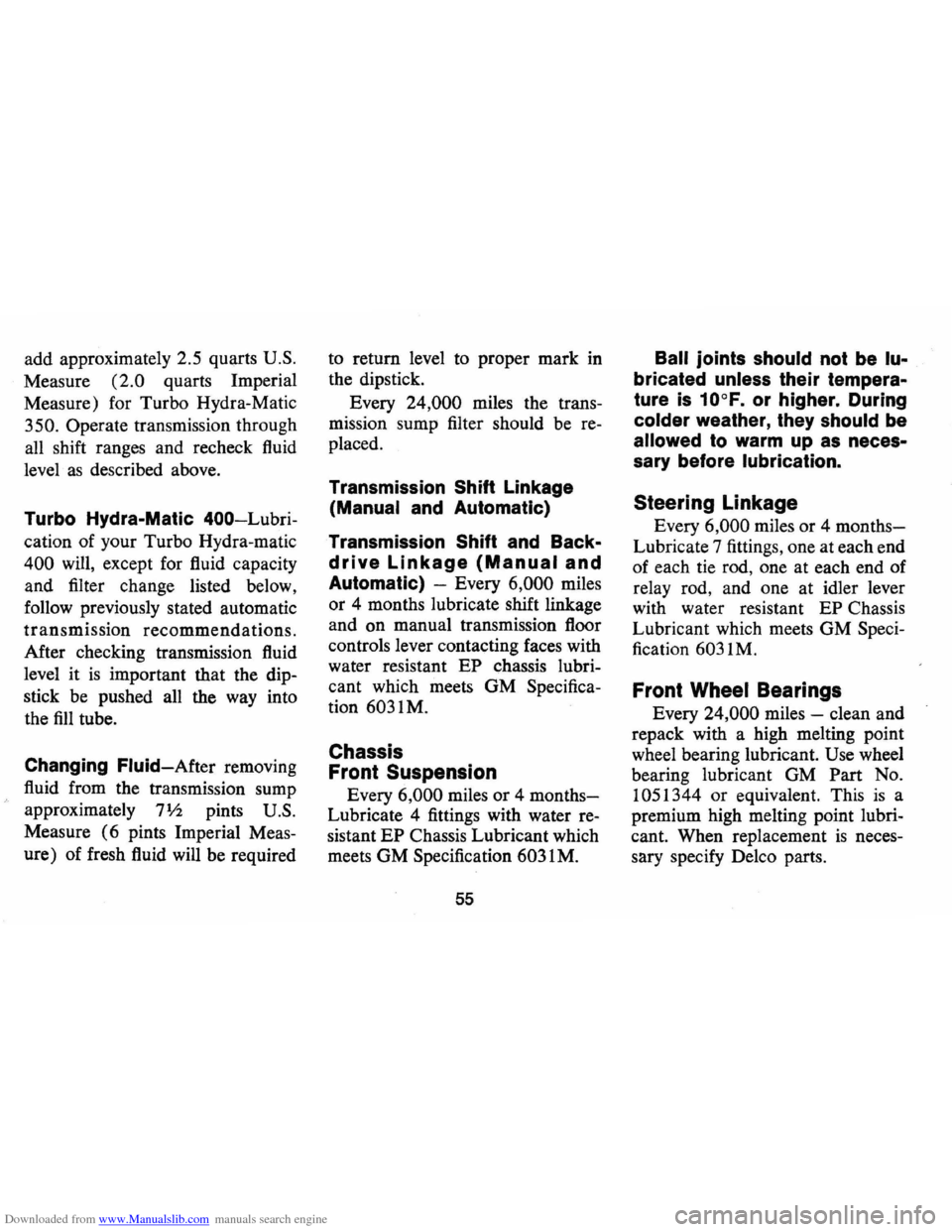
Downloaded from www.Manualslib.com manuals search engine add approximately 2.5 quarts U.S.
Measure (2.0 quarts Imperial
Measure) for Turbo Hydra-Matic
350. Operate transmission through
all shift ranges and recheck fluid
level
as described above.
Turbo Hydra-Matic 400-Lubri
cation of your Turbo Hydra-matic
400 will, except for fluid capacity
and filter change listed below,
follow previously stated automatic
transmission recommendations.
After checking transmission fluid
level it
is important that the dip
stick be pushed all the
way into
the
fill tube.
Changing Fluid-After removing
fluid from the transmission sump
approximately
7lh pints U.S.
Measure (6 pints Imperial Meas
ure) of fresh fluid will be required to
return level to proper mark in
the dipstick.
Every
24,000 miles the trans
mission sump filter should be re
placed.
Transmission Shift Linkage
(Manual and Automatic)
Transmission
Shift and Back·
drive Linkage (Manual and
Automatic) -Every 6,000 miles
or 4 months lubricate shift linkage
and on manual transmission floor
controls lever contacting faces with
water resistant EP chassis lubri
cant which meets GM Specifica
tion 6031M .
Chassis
Front Suspension
Every 6,000 miles or 4 months
Lubricate 4 fittings with water re
sistant
EP Chassis Lubricant which
meets GM Specification
6031 M.
55
Ball jOints should not be lu
bricated unless their tempera
ture
is 10°F. or higher. During
colder weather, they should be
allowed to warm up as neces
sary before
lubrication.
Steering Linkage
Every 6,000 miles or 4 months
Lubricate 7 fittings, one at each end
of each tie rod , one at each end of
relay rod, and one at idler lever
with water resistant EP Chassis
Lubricant which meets GM Speci
fication 6031M.
Front Wheel Bearings
Every 24,000 miles -clean and
repack with a high melting point
wheel bearing lubricant.
Use wheel
bearing lubricant GM Part No.
1051344 or equivalent. This
is a
premium high melting point lubri
cant. When replacement
is neces
sary specify Delco parts.
Page 58 of 86
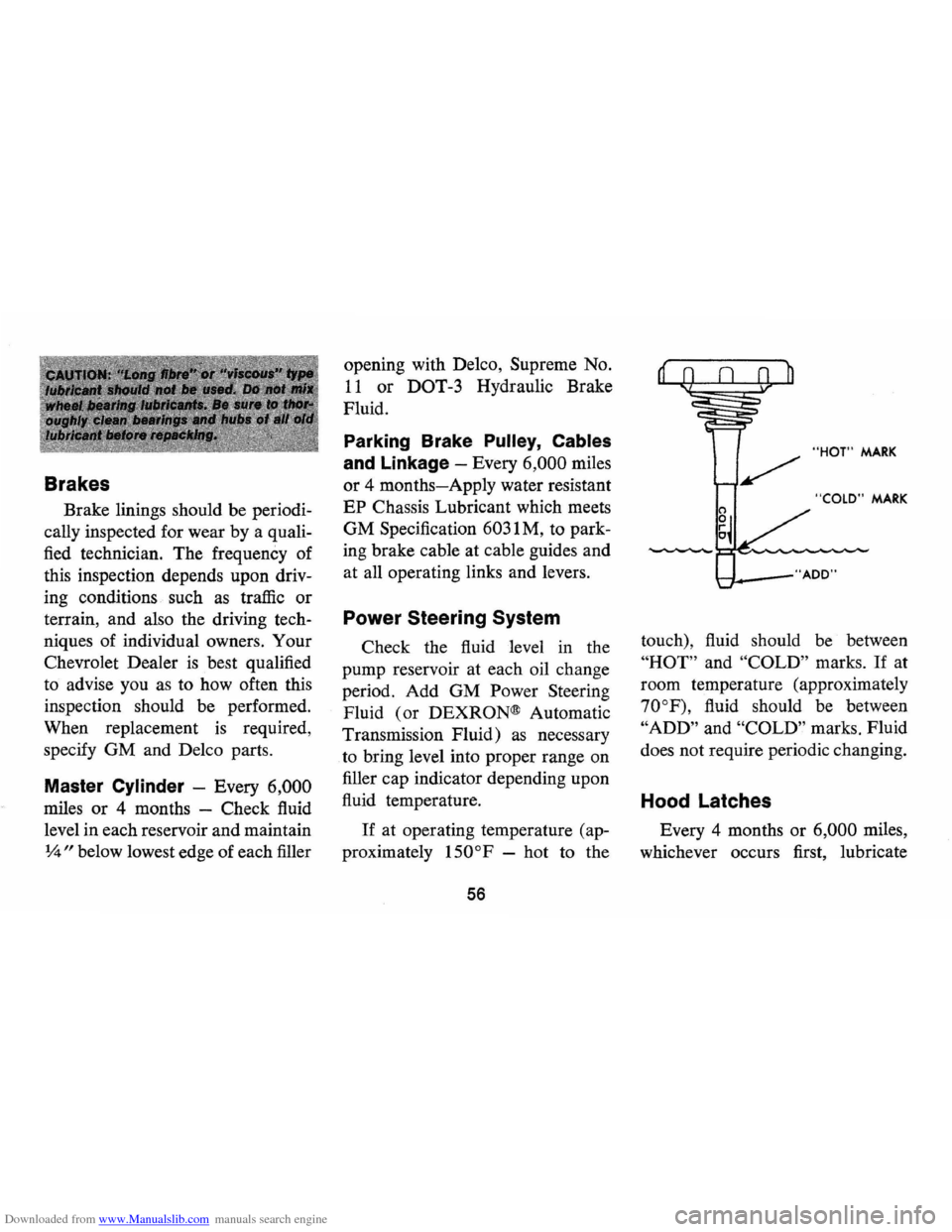
Downloaded from www.Manualslib.com manuals search engine Brakes
Brake linings should be periodi
cally inspected for wear by a quali
fied technician. The frequency of
this inspection depends upon driv
ing conditions such
as traffic or
terrain, and also the driving tech
niques of individual owners. Your
Chevrolet Dealer
is best qualified
to advise you
as to how often this
inspection should be performed.
When replacement
is required,
specify GM and Delco parts.
Master
Cylinder - Every 6,000
miles or 4 months -Check fluid
level in each reservoir and maintain
~ " below lowest edge of each filler opening
with Delco, Supreme No.
11 or DOT-3 Hydraulic Brake
Fluid.
Parking Brake
Pulley, Cables
and Linkage -Every 6,000 miles
or 4 months-Apply water resistant
EP Chassis Lubricant which meets
GM Specification 6031 M, to park
ing brake cable at cable guides and
at all operating links and levers.
Power
Steering System
Check the fluid level in the
pump reservoir at each oil change
period. Add GM Power Steering
Fluid (or
DEXRON® Automatic
Transmission Fluid)
as necessary
to bring level into proper range on
filler cap indicator depending upon
fluid temperature.
If at operating temperature (ap
proximately
150 °F - hot to the
56
"HOT" MARK
"COLD" MARK
touch), fluid should be between
"HOT" and "COLD" marks. If at
room temperature (approximately
70°F), fluid should be between
"ADD" and "COLD" marks. Fluid
does not require periodic changing.
Hood
Latches
Every 4 months or 6,000 miles,
whichever occurs first, lubricate
Page 59 of 86
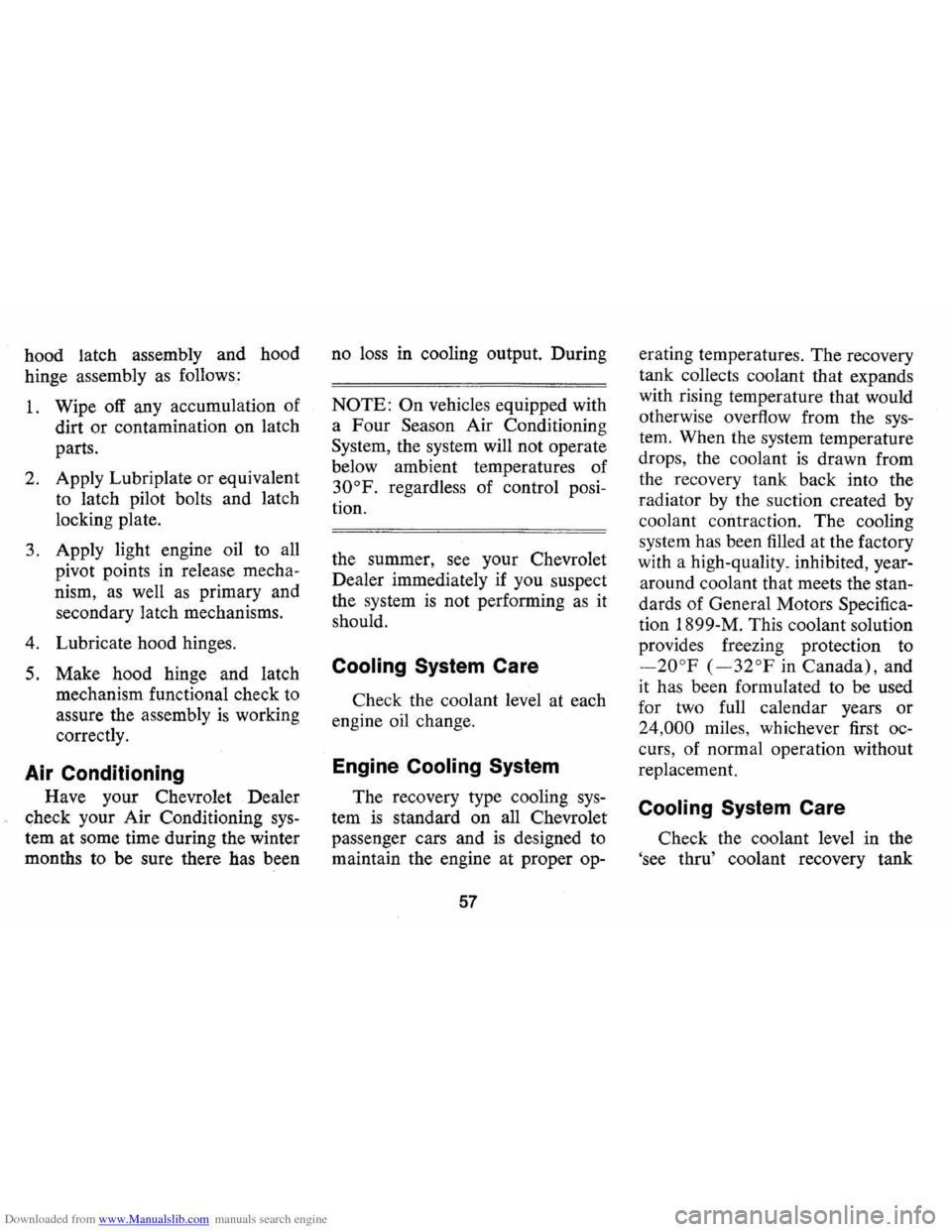
Downloaded from www.Manualslib.com manuals search engine hood latch assembly and hood
hinge assembly as follows:
1. Wipe off any accumulation of
dirt or contamination on latch
parts.
2. Apply Lubriplate or equivalent
to latch pilot bolts and latch
locking plate.
3. Apply light engine oil to all
pivot points in release mecha
nism, as well
as primary and
secondary latch mechanisms.
4. Lubricate hood hinges.
5. Make hood hinge and latch
mechanism functional check to
assure the assembly
is working
correctly.
Air Conditioning
Have your Chevrolet Dealer
check your Air Conditioning
sys
tem at some time during the winter
months to be sure there has been no
loss in cooling output. During
NOTE: On vehicles equipped with
a
Pour Season Air Conditioning
System, the system will not operate
below ambient temperatures of
300P. regardless of control posi
tion.
the summer,
see your Chevrolet
Dealer immediately if you suspect
the system
is not performing as it
should .
Cooling System Care
Check the coolant level at each
engine oil change.
Engine Cooling System
The recovery type cooling sys
tem is standard on all Chevrolet
passenger cars and
is designed to
maintain the engine at proper op-
57
erating temperatures. The recovery
tank collects coolant that expands
with rising temperature that would
otherwi se overflow from the sys
tem. When the system temperature
drops, the coolant
is drawn from
the recovery tank back into the
radiator by the suction created by
coolant contraction. The cooling
system has been filled at the factory
with a high-quality , inhibited, year
around coolant that meets the stan
dards of General Motors Specifica
tion 1899-M. This coolant solution
provides freezing protection to
-20oP (-32° P in Canada), and
it has been formulated to be used
for two full calendar years or
24,000 miles, whichever first oc
curs, of normal operation without
replacement.
Cooling System Care
Check the coolant level in the
'see thru' coolant recovery tank
Page 60 of 86

Downloaded from www.Manualslib.com manuals search engine and in the radiator at least as fre
quently
as engine oil changes.
NOTE: Do not remove radiator
cap when coolant
is hot and under
pressure.
Level should be at the
"FULL
COLD"
mark on the recovery tank
and at the bottom of the radiator
filler neck when the system
is cold.
During normal warm weather op
eration the coolant should be at
the
"FULL HOT" mark on the re
covery tank.
If the recovery tank is
empty or coolant is below the
"FULL COLD" mark the radiator
level should be checked and cool
ant added to the radiator and re
covery tank
as needed. Use a 50/50
mixture of high-quality ethylene gly
col antifreeze and water for coolant
additions.
If regular additions are
required see your dealer for a cool
ing system check.
NOTE: If recommended quaIily
antifreeze is used, supplemental in
hibitors or additives claiming to
provide increased capability are
not necessary. They may be detri
mental
to the efficient operation of
the system, and represent an un
necessary operating expense.
Every year, the cooling system
should be serviced
as follows:
1 . Wash radiator cap and filler
neck with clean water.
2. Check coolant for proper
level and freeze protection.
3. Pressure test system and radi
ator cap for proper pressure
holding capacity (15 psi).
If
replacement of cap is re
quired, use the special AC
cap designed for coolant re
covery systems, specified for
your car model.
4. Tighten hose clamps and in
spect all hoses. Replace hoses
58
whenever swollen, checked or
otherwise deteriorated.
5. Clean frontal area of radiator
core and air conditioning
condenser.
Every two years or
24,000 miles,
whichever first occurs, the cooling
system should be flushed and re
filled using the following recom
mended procedure:
1. Run engine, with radiator cap
removed, until normal operat
ing temperature
is reached
and upper radiator hose
is hot
(indicates thermostat
is open.)
2. Stop engine and open radiator
drain valve to drain coolant.
(To speed this operation, the
drain plugs in the block can
also be removed.)